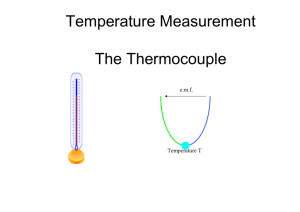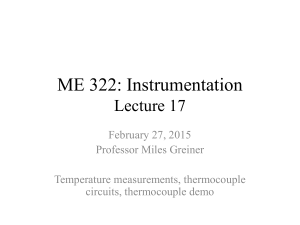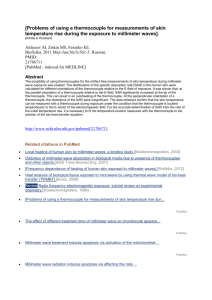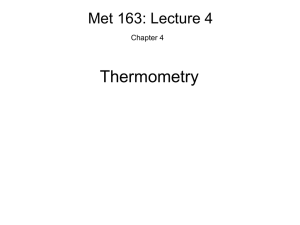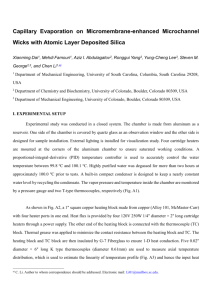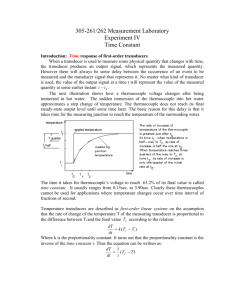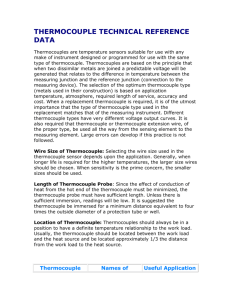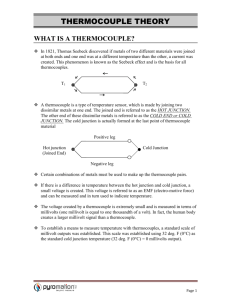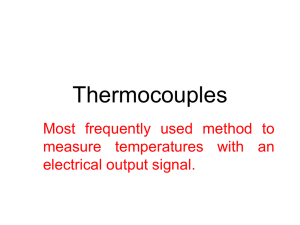305-261/262 Measurement Laboratory
advertisement
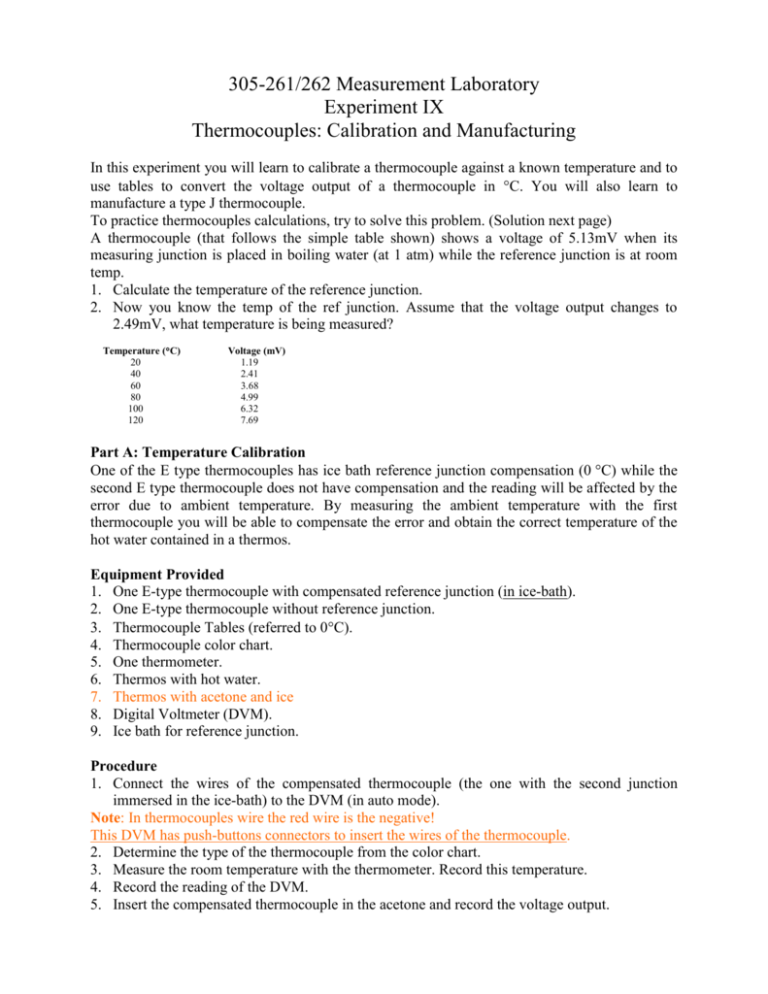
305-261/262 Measurement Laboratory Experiment IX Thermocouples: Calibration and Manufacturing In this experiment you will learn to calibrate a thermocouple against a known temperature and to use tables to convert the voltage output of a thermocouple in C. You will also learn to manufacture a type J thermocouple. To practice thermocouples calculations, try to solve this problem. (Solution next page) A thermocouple (that follows the simple table shown) shows a voltage of 5.13mV when its measuring junction is placed in boiling water (at 1 atm) while the reference junction is at room temp. 1. Calculate the temperature of the reference junction. 2. Now you know the temp of the ref junction. Assume that the voltage output changes to 2.49mV, what temperature is being measured? Temperature (C) 20 40 60 80 100 120 Voltage (mV) 1.19 2.41 3.68 4.99 6.32 7.69 Part A: Temperature Calibration One of the E type thermocouples has ice bath reference junction compensation (0 C) while the second E type thermocouple does not have compensation and the reading will be affected by the error due to ambient temperature. By measuring the ambient temperature with the first thermocouple you will be able to compensate the error and obtain the correct temperature of the hot water contained in a thermos. Equipment Provided 1. One E-type thermocouple with compensated reference junction (in ice-bath). 2. One E-type thermocouple without reference junction. 3. Thermocouple Tables (referred to 0C). 4. Thermocouple color chart. 5. One thermometer. 6. Thermos with hot water. 7. Thermos with acetone and ice 8. Digital Voltmeter (DVM). 9. Ice bath for reference junction. Procedure 1. Connect the wires of the compensated thermocouple (the one with the second junction immersed in the ice-bath) to the DVM (in auto mode). Note: In thermocouples wire the red wire is the negative! This DVM has push-buttons connectors to insert the wires of the thermocouple. 2. Determine the type of the thermocouple from the color chart. 3. Measure the room temperature with the thermometer. Record this temperature. 4. Record the reading of the DVM. 5. Insert the compensated thermocouple in the acetone and record the voltage output. 6. Insert the compensated thermocouple in the thermos to measure the temperature of the hot water. Record the readings. 7. Connect the non-compensated thermocouple to the DVM and record the reading. Now the, so-called reference junction of this thermocouple is located at the connection with the DVM. 8. Repeat steps 5 and 6 with the non-compensated thermocouple. 9. Insert the thermometer in the thermos and record the temperature of the hot water (to check your results). Results Prepare a datasheet where you report 1. The type of your thermocouples. 2. The room temperature obtained measured by the thermometer. 3. The DVM readings of procedure steps 3,4,5,6,7,8. 4. What is the temperature corresponding to these readings according to the tables? (Do not calculate the compensation). 5. Now correct the readings obtained with the non-compensated thermocouple taking into account the error introduced by the reference junction. 6. Write all your calculations. [Solution of the problem: 1)T ref. Junction = Tamb = 20C, 2) T measured = 60C] Part B: Thermocouple Manufacturing You will now learn to make a thermocouple. Equipment Provided 1. Arc welders located in two stations 2. A piece of duplex thermocouple wire. 3. Pliers, wire strippers. 4. Thermocouple color chart (to recognize the type of the thermocouples). 5. Thermocouple tables (Referred to 0 C). Procedure 1. Strip both wires at both ends about ½ to ¾ inch. 2. Twist the two wires at one end (two or three very tight twists, use the pliers). 3. Use the arc welder as follow. Clip the alligator clip (of the arc welder) on the twisted bare wires leaving the tip exposed. 4. Hold the wire from the clip leaning the tip of the twisted wires on the graphite tip of the arc welder. 5. The adjusting knob should be set at 7. Push the red button until you see a spark at the end of the wire. Observe the welding. The result should look like a small bead. Do it again if you are not satisfied of the result. 6. When the thermocouple is ready connect it to the DVM. 7. Record the reading of the DVM. 8. Insert the thermocouple in the thermos of the hot water. Record the reading output. 9. Knowing the room temperature and using the provided tables, obtain the temperature of the water.
